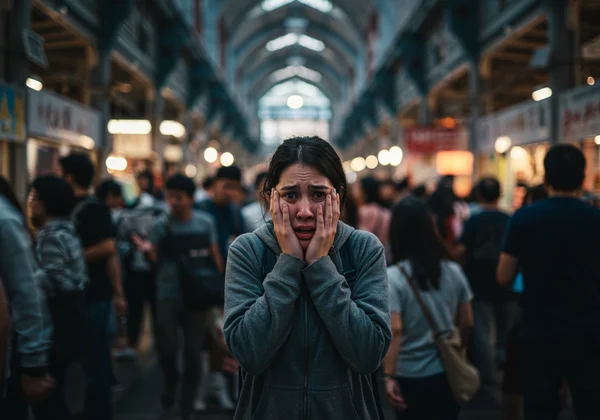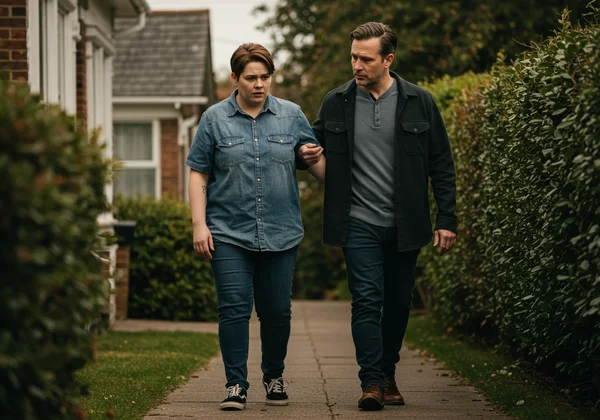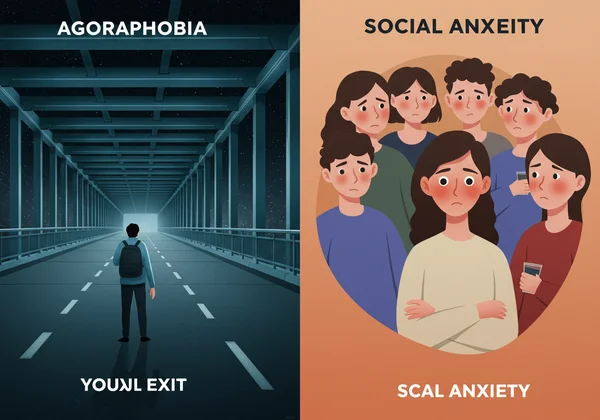Agoraphobia vs. Social Anxiety: Symptoms & Your Test
Feeling overwhelmed by intense fear in certain situations is confusing and isolating. You might find your world shrinking, but you're not sure why. Many people struggle to put a name to their anxiety, often wondering if they're experiencing agoraphobia or social anxiety. While they can feel similar, their root causes are quite different. How do I tell if I'm developing agoraphobia? This is a critical question, and gaining clarity is the first step toward managing your feelings. Understanding these differences is key to finding the right path forward, and a great place to begin is with a confidential agoraphobia test to see where you stand. For a clearer picture of your own experiences, you can start with a free self-assessment.
Decoding Agoraphobia: More Than Just Fear of Open Spaces
A common misconception is that agoraphobia is simply a fear of open spaces. In reality, it's a much more complex anxiety disorder. At its core, agoraphobia is an intense fear of being in situations where escape might be difficult or help might not be available if you have a panic attack or other incapacitating symptoms. This fear leads to significant avoidance behaviors that can severely limit a person's life. The anxiety isn't about the places themselves, but about the feeling of being trapped and helpless within them.

Understanding the Core Fear: Panic & Escape
The driving force behind agoraphobia is the fear of having a panic attack. Individuals worry intensely about experiencing symptoms like a racing heart, shortness of breath, dizziness, or a sense of impending doom in a public setting. They fear the embarrassment of others witnessing their panic or the inability to get to a place they perceive as safe, like their home. This fear of fear itself creates a powerful cycle of anxiety and avoidance, making it difficult to engage in everyday activities.
Common Situations Avoided by People with Agoraphobia
This fear of being trapped can manifest in a variety of situations. People with agoraphobia often exhibit strong avoidance behavior related to places or scenarios that trigger their anxiety. These commonly include:
- Using public transportation, such as buses, trains, or planes.
- Being in open spaces like parking lots, bridges, or large fields.
- Being in enclosed spaces like movie theaters, small shops, or elevators.
- Standing in a line or being in a crowd.
- Being away from home alone.
The list can be unique to each individual, but the common thread is the perceived difficulty of a quick and easy escape. If you find yourself consistently avoiding these types of situations, an online agoraphobia test can provide initial insight.
Can You Be Agoraphobic and Still Leave Your House?
Absolutely. This is a crucial point that many misunderstand. Agoraphobia exists on a spectrum. Some people may be completely housebound, while others can manage to leave their home under specific conditions. They might only travel within a small, familiar radius or require a safe person—a trusted friend, partner, or family member—to accompany them. The presence of this person can provide enough security to face otherwise impossible situations. So, even if you are leaving your house, but only with significant distress or specific rituals, it is still a sign worth exploring.

Exploring Social Anxiety: Fear of Judgment and Scrutiny
Social Anxiety Disorder (SAD), also known as social phobia, is characterized by an overwhelming fear of social situations. Unlike agoraphobia, the core fear is not about being trapped during a panic attack. Instead, it revolves around the intense fear of being judged, scrutinized, or negatively evaluated by other people. This fear can be so powerful that individuals go to great lengths to avoid social encounters, which can impact their careers, relationships, and overall quality of life. The focus is entirely on social performance and the potential for embarrassment or humiliation.

Key Symptoms and Triggers of Social Anxiety Disorder
The fear of judgment is central to social anxiety. Individuals worry that they will act in a way that is embarrassing or that others will notice their anxiety. Common physical symptoms include blushing, sweating, trembling, or having a shaky voice. Triggers are almost always social in nature and can include:
- Meeting new people.
- Speaking in public or in meetings.
- Eating or drinking in front of others.
- Making eye contact.
- Attending parties or social gatherings.
A person with social anxiety might avoid a crowded party not because they fear a panic attack with no escape, but because they fear having awkward conversations or being seen as uninteresting.
The Role of Social Settings in Social Anxiety
For someone with social anxiety, the context is always interpersonal. The anxiety is triggered by the presence of others and the potential for scrutiny. They are hyper-aware of their own actions and how they might be perceived. This is a key difference from agoraphobia, where the presence of people can sometimes be a comfort (a "safe person"), whereas in social anxiety, the presence of people is the very source of the fear. A person might feel perfectly fine in a crowded, anonymous space like a large market, as long as no direct social situations are expected of them.
The Core Distinction: Fear of Panic Attack vs. Fear of Social Judgment
Understanding the fundamental difference between these two conditions is the most important step toward clarity. To put it simply:
- Agoraphobia: The core fear is experiencing panic-like symptoms and being unable to escape to safety.
- Social Anxiety: The core fear is being negatively judged or scrutinized by others in a social setting.
Imagine being invited to a large concert. A person with agoraphobia might refuse to go because they fear having a panic attack in the middle of the dense crowd and being unable to get out. A person with social anxiety might refuse because they fear running into people they know and having to make conversation, worrying they'll say something foolish. The situation is the same, but the underlying reason for avoidance is completely different. A quick self-assessment can help you reflect on your own reasons for avoidance.

Why the Context of Fear Matters for Your Diagnosis
Identifying the underlying fear is critical because it points toward the most effective coping strategies and potential treatments. If you avoid crowds because you fear panic, the strategies will focus on managing panic symptoms and gradually re-entering those situations to prove your safety. If you avoid crowds because you fear judgment, the work will involve challenging negative self-perceptions and building social confidence. Misidentifying the problem can lead to frustration when coping mechanisms don't seem to work.
Agoraphobia Often Accompanies Panic Disorder: Understanding the Link
It is very common for agoraphobia to develop after a person has experienced one or more unexpected panic attacks. This link to panic disorder is a defining feature. The person begins to associate the place where they had the attack with the terrifying feelings of panic. As a result, they start avoiding that place, and this avoidance can generalize to other similar situations, eventually snowballing into full-blown agoraphobia. While social anxiety can also involve panic attacks, they are specifically triggered by feared social situations.
How to Tell Them Apart: A Practical Symptom Checklist for Clarity
Sometimes, reading definitions isn't enough. It helps to apply these concepts directly to your own experiences. The goal is not to self-diagnose but to gain a clearer understanding of your feelings, which you can then explore further. A helpful first step could be taking an am I agoraphobic quiz to get a structured perspective.
Self-Assessment Questions for Initial Understanding
Take a moment for some honest self-reflection. Ask yourself these questions when thinking about a situation you avoid:
- When I think about going into that situation, is my main worry about what other people will think of me? (More likely Social Anxiety)
- Or is my main worry that I will have a panic attack and won't be able to leave or get help? (More likely Agoraphobia)
- Do I feel better if a trusted friend or family member is with me? (Common in Agoraphobia)
- Do I feel more anxious if I am with people, especially ones I don’t know well? (Common in Social Anxiety)
- Do I avoid situations even when I'm alone, like crossing a bridge or driving far from home? (More likely Agoraphobia)
When Symptoms Overlap: The Comorbidity Factor
To make matters more complex, it is possible for a person to have both agoraphobia and social anxiety. This is known as comorbidity. Someone might fear being judged in social situations, and that fear could become so intense that it triggers a panic attack. Subsequently, they might develop a fear of having another panic attack in that situation, blending the two conditions. Untangling these overlapping fears is a crucial part of achieving mental health clarity and often benefits from professional guidance.
Beyond Confusion: Your Path to Clarity and Support
Distinguishing between agoraphobia and social anxiety is more than just an academic exercise—it's a vital step in reclaiming your life from fear. By identifying the specific nature of your anxiety, you empower yourself to seek the right kind of support and learn the most effective coping strategies. Remember, this journey starts with a single step of understanding. You are not alone in this struggle, and clarity is within reach.
Taking the Next Step: Your Free Agoraphobia Self-Assessment
If you suspect your fears are more aligned with being trapped or having a panic attack, the next logical step is to explore it further. Our website offers a free, quick, and completely confidential online tool designed to help you understand your symptoms. This is not a diagnosis, but a valuable resource to help you see your experiences more clearly. Take the free agoraphobia test today to gain a personalized perspective and find guidance on what to do next.
Frequently Asked Questions About Agoraphobia & Social Anxiety
How do you test for agoraphobia?
A formal diagnosis must be made by a qualified healthcare professional, like a psychologist or psychiatrist. However, a preliminary step can be a self-screening tool. An online agoraphobia test like the one on our site asks questions based on established diagnostic criteria to give you a risk assessment. You can then share these results with a professional as a starting point for discussion.
What can agoraphobia be mistaken for?
Agoraphobia is most commonly mistaken for social anxiety, as both can lead to avoiding public places. It can also be confused with specific phobias (like claustrophobia, the fear of enclosed spaces) or Generalized Anxiety Disorder (GAD). The key differentiator for agoraphobia is that the avoidance is linked to the fear of panic-like symptoms and the inability to escape.
Can you be agoraphobic and still leave the house?
Yes. This is a common point of confusion. Agoraphobia exists on a spectrum. Many individuals with agoraphobia can and do leave their homes, but they do so with significant distress or by relying on "safety behaviors," such as only traveling short distances, avoiding specific routes, or needing a trusted companion. The diagnosis is based on the fear and avoidance, not just on being housebound.
Is there a spectrum for agoraphobia?
Yes, definitely. Agoraphobia can range from mild to severe. A person with mild agoraphobia might feel anxious on highways or in large malls but can still manage these situations. Someone with severe agoraphobia may be unable to leave their home at all. An agoraphobia symptoms test can help you understand where your experiences might fall on this spectrum.